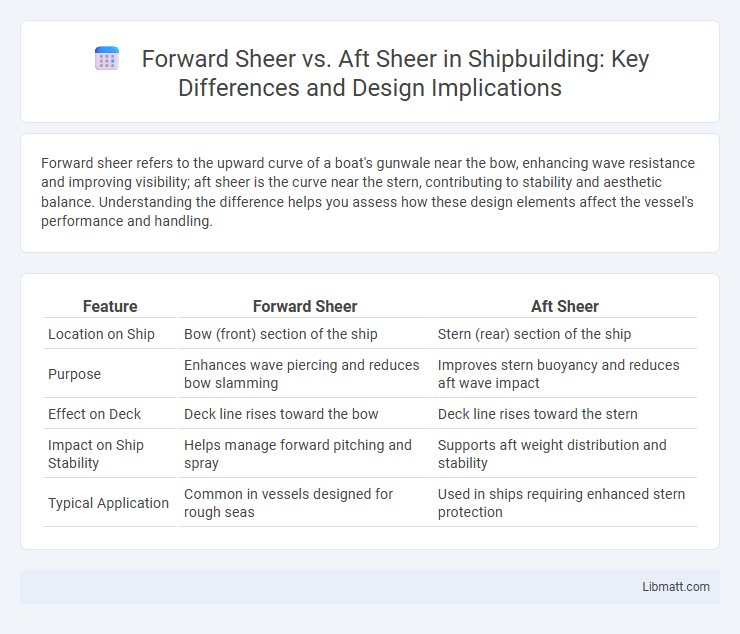Forward sheer refers to the upward curve of a boat's gunwale near the bow, enhancing wave resistance and improving visibility; aft sheer is the curve near the stern, contributing to stability and aesthetic balance. Understanding the difference helps you assess how these design elements affect the vessel's performance and handling.
Table of Comparison
| Feature | Forward Sheer | Aft Sheer |
|---|---|---|
| Location on Ship | Bow (front) section of the ship | Stern (rear) section of the ship |
| Purpose | Enhances wave piercing and reduces bow slamming | Improves stern buoyancy and reduces aft wave impact |
| Effect on Deck | Deck line rises toward the bow | Deck line rises toward the stern |
| Impact on Ship Stability | Helps manage forward pitching and spray | Supports aft weight distribution and stability |
| Typical Application | Common in vessels designed for rough seas | Used in ships requiring enhanced stern protection |
Introduction to Sheer in Ship Design
Sheer in ship design refers to the longitudinal curvature of a vessel's deck from bow to stern, contributing to structural integrity and seaworthiness. Forward sheer describes the upward curve toward the bow, enhancing wave resistance and improving deck drainage, while aft sheer refers to the curvature toward the stern, aiding in buoyancy and stability. Proper balance between forward and aft sheer is critical for optimizing ship performance and maintaining hull strength under dynamic sea conditions.
Defining Forward Sheer
Forward sheer refers to the upward curve of a ship's deck towards the bow, enhancing seaworthiness by allowing water to run off quickly and improving visibility from the bridge. It contrasts with aft sheer, which is the upward curve towards the stern, primarily aiding in housing and stability. Forward sheer plays a critical role in vessel design by boosting wave deflection and reducing the likelihood of green water on deck during rough seas.
Understanding Aft Sheer
Aft sheer refers to the upward curve of a ship's deckline toward the stern, enhancing seaworthiness by improving water runoff and reducing deck water accumulation. This design element contributes to better stability and structural strength in rough sea conditions, especially on vessels with significant aft weight. Understanding aft sheer is crucial for naval architects aiming to optimize ship performance and safety during operations.
Historical Evolution of Sheer Lines
Sheer lines historically evolved from the pronounced, upward-curving forward sheer characteristic of early wooden sailing vessels to the more balanced and sometimes aft-raked sheer lines seen in modern yacht designs. The forward sheer originally enhanced buoyancy and wave-clearing ability at the bow, reflecting the functional seafaring needs of centuries past. Advances in naval architecture and materials allowed contemporary designers to experiment with aft sheer, optimizing aesthetics, hull strength, and deck space while maintaining seaworthiness.
Engineering Principles Behind Sheer Placement
Forward sheer enhances structural integrity by improving longitudinal strength and distributing stress more efficiently along the vessel's bow, accommodating wave impact and optimizing hydrostatic balance. Aft sheer, positioned aft near the stern, focuses on stability and buoyancy enhancement, counteracting stern immersion under load by adjusting the hull curvature. Both sheer placements are engineered to optimize hull performance, balancing hydrodynamic efficiency with structural resilience against varying sea conditions.
Impact of Forward Sheer on Vessel Performance
Forward sheer, which refers to the upward curve of a vessel's deck line toward the bow, enhances seaworthiness by improving wave deflection and reducing spray on deck. This design feature increases stability and buoyancy in rough seas, contributing to safer navigation and better fuel efficiency. Your vessel benefits from forward sheer through smoother passage and decreased structural stress during heavy weather conditions.
Aft Sheer and Its Influence on Seaworthiness
Aft sheer refers to the upward curvature of a ship's hull towards the stern, significantly enhancing seaworthiness by improving wave handling and reducing water shipping on deck. This design element increases buoyancy at the stern, contributing to better stability in rough seas and minimizing the risk of stern submersion. Ships with pronounced aft sheer demonstrate improved agility and safety during heavy weather, directly impacting overall vessel performance and crew safety.
Forward vs Aft Sheer: Comparative Analysis
Forward sheer enhances visibility and aerodynamic efficiency by tilting the wing slightly forward, commonly found in high-performance aircraft and gliders. Aft sheer improves structural integrity and stall characteristics, often utilized in cargo planes and bombers for better load distribution and stability. Comparing both, forward sheer prioritizes maneuverability and speed, while aft sheer emphasizes durability and payload capacity.
Modern Trends in Sheer Design for Ships
Modern trends in ship design emphasize forward sheer to enhance bow wave piercing and improve fuel efficiency, while aft sheer is minimized to optimize deck space and stability. Advances in computational fluid dynamics (CFD) guide designers in balancing sheer for hydrodynamic performance and aesthetic appeal. The integration of variable sheer profiles tailored to specific vessel types reflects a shift towards customized, performance-driven hull forms.
Conclusion: Optimizing Sheer for Functional and Aesthetic Value
Optimizing sheer between forward and aft designs requires balancing structural integrity with aesthetic appeal to enhance overall vessel performance. Forward sheer offers improved wave handling due to increased bow height, while aft sheer provides aesthetic flow and deck drainage benefits. Selecting the appropriate sheer depends on the intended use, ensuring the vessel maintains stability, seaworthiness, and visual harmony.
Forward sheer vs aft sheer Infographic

 libmatt.com
libmatt.com